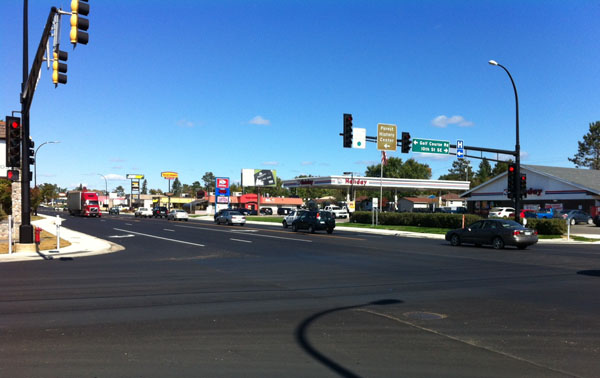By Lisa Yang

Accessibility improvements were made in several areas as part of the Hwy 169/Pokegama Avenue project in Grand Rapids. Crosswalk markings will be put in next year and the project will be complete in June 2013. Photo by Dana Marrier |
Construction is wrapping up for this year on Hwy 169/Pokegama Avenue in Grand Rapids, a project that features several accessibility improvements for pedestrians, including:
- Curb ramps with detectable warnings
- New sidewalks with accessible driveway crossings
- Accessible pedestrian signal upgrades at four intersections
“We recognized this project as an opportunity to provide a long-term fix for all users,” said Krysten Saatela, project development engineer. “Along with replacing underground utilities and improving pavement smoothness for drivers, MnDOT staff also applied careful engineering along the sidewalks to ease pedestrian travel between nearby residences and businesses.”
Shortly after construction was completed on the first stage of the project along the west side of Hwy 169, MnDOT staff noticed an increase in the use of the new sidewalks, curb ramps and accessible, signalized crossings.
“These accessibility improvements help change peoples’ ability to get around,” said Dana Marrier, District 1 chief inspector.
A resident who is a double-amputee wheelchair user commented that before the improvements were made, it was challenging for him to navigate the sidewalk, according to Marrier. That resident is now able to wheel up and down the area every day.
“It greatly improves the quality of life for individuals with and without disabilities,” Marrier said.
Several other employees were involved in planning and implementing the accessibility improvements, including Kevin Rohling, project engineer; and Todd Grugel, Americans with Disabilities Act program engineer.
During construction, Grugel and his team visited the project with Rohling and discussed widening the sidewalks in areas where there was sufficient right of way in order to make it more user-friendly, which allowed for better driveway and curb ramp construction.
“Kevin listened to the ideas, negotiated a work order with the contractor and ran with them,” Grugel said. “It was by far the best money we could have spent from an ADA perspective.”
Rohling said the department is better able to meet ADA compliance guidelines in a reconstruction situation because “we are working with more pieces of the puzzle.”
“An example of this would be, we can position such things as a drainage structure so it is not too close to a ramp and affecting slopes.”
Before the final plan was to be turned in, Grugel and his staff worked with District 1’s Design Office and made some modifications to the plan. They also piloted an enhanced, special provision called ‘1803 Prosecution of Work’ for special project ADA requirements. These requirements put more responsibility on the contractor to coordinate the ADA work, as well as complete and submit the ADA compliance check lists for payment.
Overall, the project has been well received by the public, according to Rohling and Grugel. The work this year, completed ahead of schedule, provides a new continuous center left turn lane from one end to the other and a continuous right turn lane for three blocks of the reconstruction section. This allows for more efficient and safer travel through a busy corridor where many fast food restaurants are located.
“From an ADA standpoint, this is the best overall project I’ve seen in my two and a half years of monitoring ADA projects on a statewide basis,” Grugel said. “Not only was the project completely compliant, but it was easy to notice the attention to detail put in by both the contractor and MnDOT field staff that made the new curb ramps, sidewalks, driveways and crosswalks truly user-friendly.
It certainly goes to show that a project can fail or succeed on many levels or stages, but a dedicated and conscientious project team can make all the difference.” |



